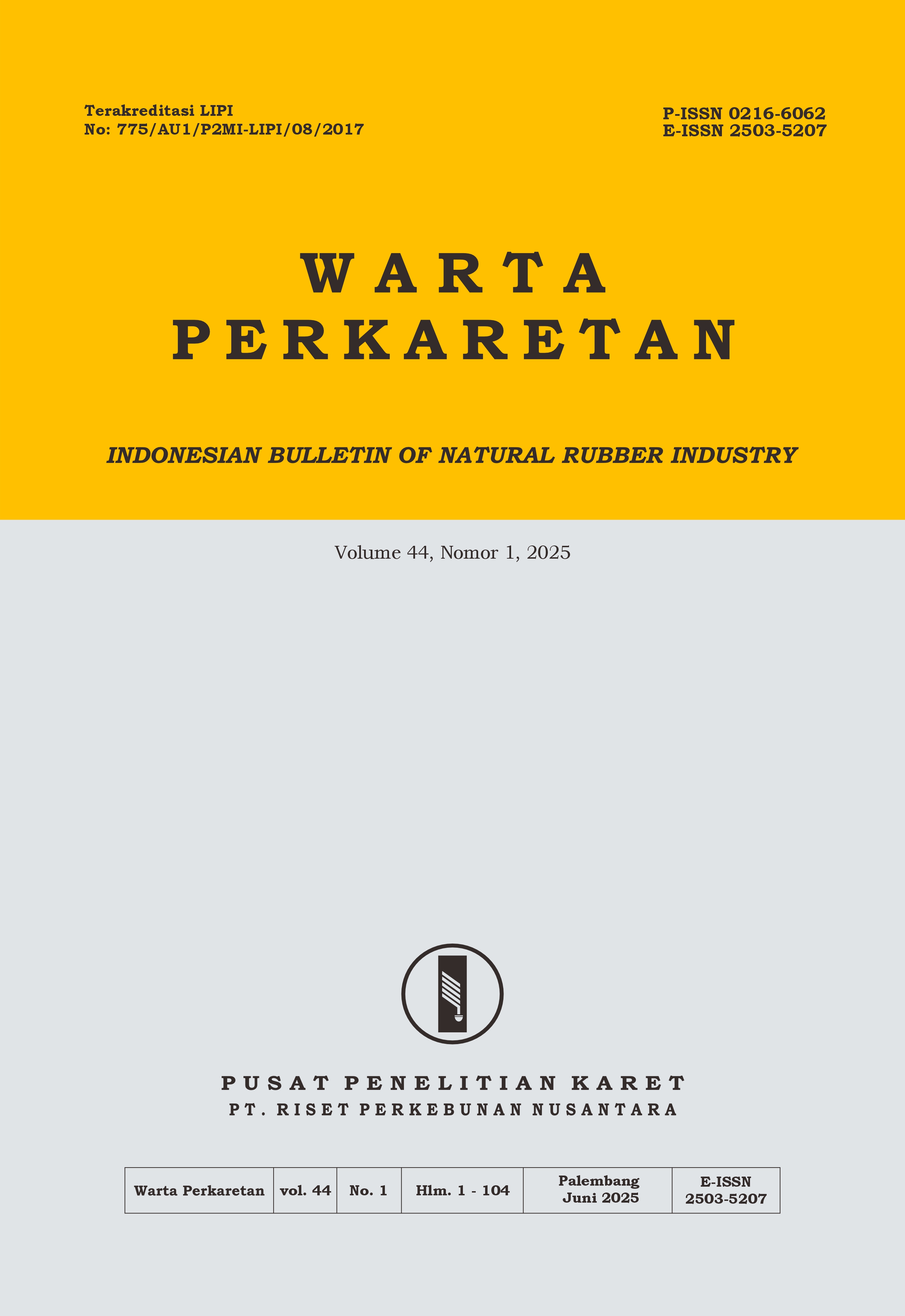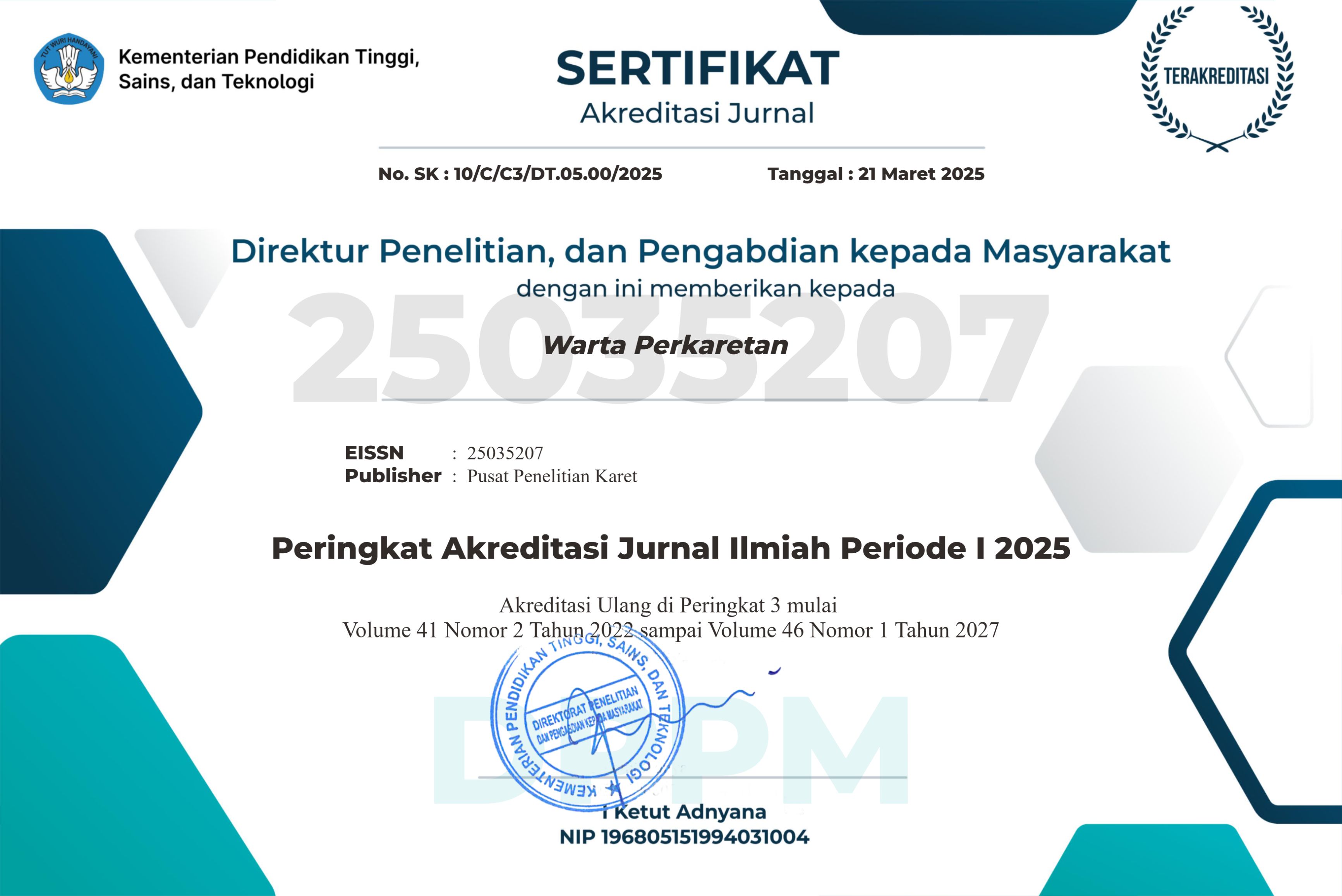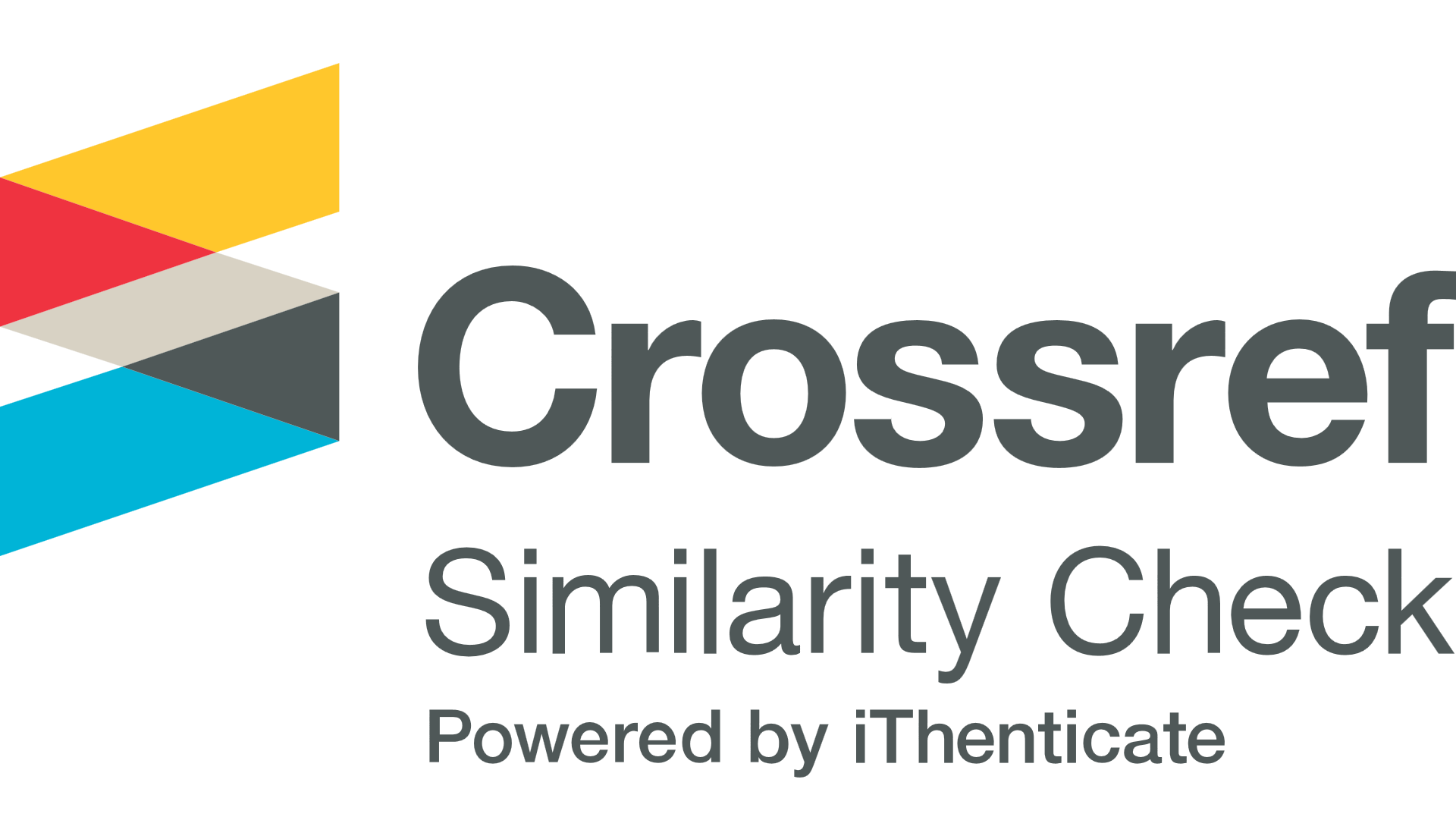HUBUNGAN FAKTOR LINGKUNGAN DAN ALIRAN LATEKS TERHADAP PRODUKSI KARET PADA AWAL MUSIM GUGUR DAUN ALAMI
DOI:
https://doi.org/10.22302/ppk.wp.v44i1.1134Keywords:
indeks penyumbatan, luas kanopi, KKK, aliran lateks, musim kemarauAbstract
Faktor internal yang berpengaruh terhadap produksi karet adalah kadar karet kering (KKK), indeks penyumbatan dan kondisi kanopi tanaman karet sedangkan faktor eksternal kondisi lingkungan seperti kadar air tanah dan kelembaban nisbi, serta interaksi kedua faktor tersebut. Dinamika perubahan musim berpengaruh terhadap produksi karet. Penelitian observasi ini bertujuan mengkaji hubungan antara faktor-faktor yang mempengaruhi produksi karet pada awal musim gugur daun alami. Pengamatan dilaksanakan selama satu bulan menjelang gugur alami pada bulan Juli 2023, di Kebun Percobaan Sembawa, Sumatera Selatan. Kondisi tanaman karet selama pengamatan mulai periode gugur alami dan sedang terpapar oleh penyakit gugur daun sekunder. Tiga jenis klon karet yang diobservasi termasuk ke dalam kelompok klon metabolisme medium yaitu IRR 112, IIR 118 dan BPM 107, tahun tanam 2010, dengan posisi sadapan di B0-2. Parameter yang diamati meliputi indeks penyumbatan, KKK, luas kanopi dan kelembaban nisbi. Data yang diperoleh dianalisis korelasi dan regresi antar parameter tersebut. Indeks penyumbatan berkorelasi nyata dengan produksi karet, sedangkan KKK tidak nyata korelasinya dengan produksi karet. Indeks penyumbatan berkorelasi positif dengan KKK, yaitu semakin meningkat KKK menyebabkan aliran lateks lebih pendek. Luas kanopi berpengaruh terhadap peningkatan KKK tetapi kurang berpengaruh terhadap lamanya aliran lateks. Pada awal musim kemarau dan tanaman terpapar penyakit daun, kelembaban nisbi berkorelasi negatif dengan KKK dan luas kanopi.
References
Aji M., Supijatno S., Santosa E. 2021. Produksi Klon IRR 112 Pada Sistem Sadap Yang Berbeda. J. Penelitian Karet, 39(1): 11 – 20. https://doi.org/10.22302/ppk.jpk.v39i1.766.
An F., Lin W., Cahill D. Rookes J., Kong L. 2014. Variation of Turgor Pressure in Hevea brasiliensis: Impementation for Latex Yield and Tapping System Optimazation. Industrial and Crop Products. 3: 182 – 187. https://doi.org/10.1016/j.indcrop.2014.04.016.
Andrianto M., Sinurat I., Junaidi, Rachmawan A., Tistama R. 2022. The effect of the Ethephon Concentration on Yield and Latex Physiology of Newly Open Tapping Rubber Tree in Secondery Leaf Fall Disease Affected Area. J. Nat Rubb Res., 40(2): 63 – 67. http://dx.doi.org/10.22302/ppk.jpk.v40i2.819.
Ardika R. Cahyo A.N., Wijaya T., 2011. Wintering and Yield Dynamics on Various Rubber Clones and Their Relationship to Soil Water Content. Indonesian Natural Rubber Journal, 29(2): 102 – 109.
Ardika R., Cahyo A.N., Wijaya T. 2017. Dinamika Gugur Daun dan Produksi Berbagai Klon Karet Kaitannya dengan Kandungan Air Tanah. Jurnal Penelitian Karet, 29(2): 102. http://dx.doi.org/10.22302/jpk.v29i2.242.
Association of Natural Rubber Producing Countries. 2021. Rubber Market Inteligent Report. https://www.anrpc.org.
Atminingsih, Naiptupulu, Siregar T.H.S. 2016. Influence of Stimulant Concentrations on Latex Physiology of Several Rubber Clones (Hevea brasiliensis, Muell Arg). Indonesian J. Nat.Rubb Res., 34(1): 13 -24. http://doi.org/ https://doi.org/10.22302/ppk.jpk.v34i1.219
Cahyo A.N., Ardika R., Wijaya A. 2024. Relationship between Soil Water Content and Dry Rubber Content of Rubber Tree's Latex. Warta Perkaretan. 43(1): 17 -28. https://doi.org/10.1016/S0176-1617(89)80142-7
Damiri N., Pratama Y., Febbiyanti T.R., Rahim S.E., Astuti D.T., Purwanti Y. 2022. Pestalotiopsis sp. infection causes leaf fall disease of new arrivals in several clones of rubber plants. Biodeversitas, 23(8): 3943 – 3949. DOI: 10.13057/biodiv/d230811.
Darojat M.R., Sayurandi. 2018. The Status of IRR Series Rubber clones from Indonesia Breeding Activities ans Its Adoption in Indonesia Rubber Plantation. Perspektif 179(2): 101 – 116. DOI: http://dx.doi.org/10.21082/psp.v17n2.2018.
Daslin A., Pasaribu S.A., 2015. Adaptation Test of IRR Series Rubber Clones at Dry Climate Sungei Baleh Asahan District North Sumatra. J. of Nat. Rubb. Res. 33(1): 25 – 34.
Daslin, A. 2014. Perkambangan Penelitian klon Karet unggul Seri 100 sebagai Penghasil Lateks dan Kayu. Warta Perkaretan 33(1) : 1 -10. http://doi.org/1022302 /ppk.wp.v33i.44.
de Bei, R., Fuentes, S., Gilliham, M., Tyerman, S., Edwards, E., Bianchini, N., Smith, J., Collins, C. 2016. VitiCanopy: A free computer App to estimate canopy vigor andporosity for grapevine. Sensors 16(4): E585. https://doi.org/10.3390/s16040585
Dixit, S., Sivalingam, P. N., Baskaran, R. M., Senthil-Kumar, M., & Ghosh, P. K. 2024. Plant responses to concurrent abiotic and biotic stress: unravelling physiological and morphological mechanisms. Plant Physiology Reports, 29(1): 6-17.
Dusotoit-Coucaud A, Brunel N, Kongsawadworakul P, Viboonjun U, Lacointe A, Julien JL, Chrestin H, Sakr S. 2009. Sucrose importation into laticifers of Hevea brasiliensis, in relation to ethylene stimulation of latex production. Ann Bot, 104(4) :635-47. http://doi.org/10.1093/aob/mcp150. Epub 2009 Jun 30. PMID: 19567416; PMCID: PMC2729633.
Emuedo O.A., Omokhafe K.O., Ohimhena F.U., Uzunuigbe E.O., Uwumarongie A.M.D., Chukwuka A.N., Ugiagbe-Ekue U., Omorogbe J.A., Ehiwe D. 2017. Basal Studies of Mortex as a latex stimulant of Hevea brasiliensis. Journal of Scientific and Engineering Research, 4(12) :472-476.
Fibriana R., Ginting Y.L., Ferdiansyah E., Mubarak S. 2018. Analisis Besar atau Laju Evapotranspirasi pada Daerah Terbuka. Agrotekma, 2(2): 130 – 137.
Ginting C., Astuti Y.T.M. 2017. Penggunaan Infus Nutrisi untuk Meningkatkan Produksi Karet. Agroista Jurnal Agroteknologi, 01(2): 163 – 170.
Hee Kim K., & Mon Lee Byung. 2023. Effects of Climate Change and Drought Tolerance on Maize Growth.Plants, 12(3548): 20 pages. https://doi.org/10.3390/plants12203548
Iida S., Shimizu T., Tamai K., Kabeya N., Shimizu A., Ito E., Ohniku Y., Chann S., keth N. 2015. Interrelationships among dry season leaf fall, leaf flush and transpiration: insights from sap flux measurements in a tropical dry deciduous forest. Ecohydrology, 9(3): 472-486. http://doi.org/10.1002/eco.1650
International Rubber Study Group. 2021. Rubber Industry Report. https://www.rubberstudy.org/reports.
Junaidi J., Clément-VidalA., Nuringtyas T.R., Gohet G., Subandiyah S., Montoro P. 2023. A meta-analysis of latex physiology studies reveals limited adoption and difficulties to interpret some latex diagnosis parameters in Hevea brasiliensis. Hayati, 30(2): 358 – 371. http://doi.org/10.4308/hjb.30.2.358-371.
Kumagai T., Mudd R.G., Miyasawa Y., Liu W., Giambelluca T.W., Kobayasi N., Lim T.K., Jumora M., Matsumoto K., Hunag M., Chen Q. Ziegler A., Yin S. 2013. Simulation of canopy CO2/H2O fluxes for a rubber (Hevea brasiliensis) plantation in central Cambodia: The effect of the regular spacing of planted trees. Ecological Modelling, 265: 124 – 135. https://doi.org/10.1016/j.agrformet.2015.06.011
Lahlali, R., Taoussi M., Laasi S.E., Gachara G., Ezzaaggari R., Belabess Z., Aberkani K., Assougamen A., Meddich A., El-Jarroudi M., Barka E.A., 2024. Effects of climate change on plant pathogens and host-pathogen interactions. Crop and Evironment, 3(3):159 – 170. https://doi.org/10.1016/j.crope.2024.05.003
Lasminingsih M. 2015. Rekomendasi Klon karet Periode 2010 – 2014. Leaflet. Balai Penelitian Sembawa, Pusat Penelitian Karet
Lim, J. A., Yaacob, J. S., Mohd Rasli, S. R. A., Eyahmalay, J. E., El Enshasy, H. A., & Zakaria, M. R. S. (2023). Mitigating the repercussions of climate change on diseases affecting important crop commodities in Southeast Asia, for food security and environmental sustainability—A review. Frontiers in Sustainable Food Systems, 6: 1030540. https://doi.org/10.3389/fsufs.2022.1030540
Ling Z., Shi Z., Gu S., Wang T. 2022. Impact of Climate Change and Rubber (Hevea brasiliensis) Plantation Expansion on Reference Evapotranspiration in Xishuangbanna, Southwest China. Frontier in Plant Science, 13:830519. https://doi.org/10.3389/fpls.2022.830519.
Long X, Li H, Yang J, Xin L, Fang Y, He B, Huang D, Tang C. 2019. Characterization of a vacuolar sucrose transporter, HbSUT5, from Hevea brasiliensis: involvement in latex production through regulation of intracellular sucrose transport in the bark and laticifers. BMC Plant Biol.;19(1):591. http://doi.org/10.1186/s12870-019-2209-9
Long X., Fang Y., Qin Y., Yang J., Xiao X. 2021. Latex-specific transcriptome analysis reveals mechanisms for latex metabolism and natural rubber biosynthesis in laticifers of Hevea brasiliensis. Industrial Crops and Pruducts (171): https://doi.org/10.1016 /j.indcrop.2021.113835
Lopez D., Mariuwa B.A., Brown D., Stephane-Vanisse J. 2016. The Hevea brasiliensis XIP aquaporin subfamily: genomic, structural and functional characterizations with relevance to intensive latex harvesting. Plant Molecular Biology, 91(4-5): 1 – 14. http://doi.org/10.1007/s11103-016-0462-y
Milford, G. (1969). Latex vessel plugging, its importance to yield and clonal behaviour. J. of the Rubb. Res. Institute of Malaya, 21, 274-281.
Moreno R.M.B., Ferreira M.,Goncalves P.S., Mattoso L.H.C. 2005. Tecnology Properties of Latex and Natural Rubber of Hevea brasiliensis Clones. Sci. Agric. (Piracicaba, Braz.), 62(2) : 122-126. https://doi.org/10.1590/S0103-90162005000200005
Saputra J., Ardika R., Stevanus C.T. 2022. Produksi Tanaman Karet Klon IRR 118 di Lahan Gambut. Warta Perkaretan, 41(2): 61 – 68. https://doi.org/10.22302/ppk.wp.v41i2.905
Sayurandi, Wirnas D., Woelan S. 2017. The Genotype x Season Interaction of Latex Physiology Characters and Yield Potential of Some Rubber Genotypes Crossing Result in 1992. Warta Perkaretan 36(2): 99 – 112.
Singh B.K., Delgado-Baquerizo M., Egidi E., Guiradi E., Leach J.E., Liu H., Trivendi P. 2023. Natures Review Microbiology, 21: 640 – 656. https://doi.org/10.1038/s41579-023-00900-7.
Sumarmadji, Siregar T.H.S., Junaidi U. 2005. Optimasi produktivitas klon karet melalui berbagai sistem eksploitasi. Prosiding Lokakarya Nasional Pemuliaan Tanaman Karet. hal: 123 – 140.
Sumarmadji, Siswanto, Yahya S., 2004. Penggunaan Parameter Fisiologi Lateks untuk Penentuan Sistem Eksploitasi Tanaman Karet. Jurnal Penelitian Karet, 22(1): 41 – 52.
Tang C, Huang D, Yang J, Liu S, Sakr S, Li H, Zhou Y, Qin Y. 2010. The sucrose transporter HbSUT3 plays an active role in sucrose loading to laticifer and rubber productivity in exploited trees of Hevea brasiliensis (Para rubber tree). Plant, Cell and Environment. 33(10) :1708–1720. http://doi.org/10.1111/j.1365-3040.2010.02175.
Tistama R. 2013. Peran seluler etilen eksogenus terhadap peningkatan produksi lateks pada tanaman karet (Hevea brasiliensis L). Warta Perkaretan, 32(1): 25 – 37.
Uthup T.K., Rajamani A., RavindarM. Saha T. 2019. Distinguishing CPT gene family members and vetting the sequence structure of a putative rubber synthesizing variant in Hevea brasiliensis. Gene, 689: 183 – 193. https://doi.org/10.1016/j.gene.2018.12.001
Velasco N.F., Ramos V.F., Magnitsky S., Lopez HB. 2024. Ethylene and jasmonate as stimulants of latex yield in rubber trees (Hevea brasiliensis): Molecular and physiological mechanisms. A systematic approximation review. Advanced Agrochem, 3(4): 279 -288. https://doi.org/10.1016/j.aac.2024.07.003
Waidyanatha UP, Pathiratne LSS. 1971. Studies on latex flow patterns and plugging indices of clones. Journal of Rubber Research Institute of Sri Lanka, 48 :47-55.
Woelan S., Sayurandi, Irwansyah E. 2014. Keragaman Genetik Tanaman Karet (Hevea brasiliensis) dari hasil persilangan interspesifik. Jurnal Penelitian Karet, 32(2): https://doi.org/10.22302/jpk.v32i2.157
Yamashita S., and Takahashi. 2020. Molecular Mechanisme of Natural Rubber Biosynthesis. In The Annual Review of Biochemistry is online at biochem.annualsreviews.org. 89: 821-851. https://doi.org/10.1146/annurev-biochem-013118-111107.
Yang X., Blagodatsky S., Maronh C., Liu H., Galbon R., Xu J., Cadisc G. 2019. Climbing the mountain fast butsmart: Modeling rubber tree growth and latex yield under climate change. Forest Ecology and Management, 439: 55-69. https://doi.org/10.1016/j.tfp.2022.100285.
Downloads
Published
How to Cite
Issue
Section
License
Copyright (c) 2025 radite radite tistama

This work is licensed under a Creative Commons Attribution-NonCommercial-ShareAlike 4.0 International License.
Submission of a original research or review articles in Warta Perkaretan implies that the submitted  manuscript has not been published in any scientific journal (except being part of the abstract, thesis, or report). The submitted manuscript also is not under consideration for publication elsewhere. All co-authors involve in the publication of the manuscript should give their approval. Once, the manuscript is accepted and then published in Warta Perkaretan, the Author(s) keep hold the copyright and retain publishing right without restrictions. Author(s) and Warta Perkaretan users are allowed to multiply the published manuscript as long as not for commercial purposes. The journal users are also permissible to share the published manuscript with an acknowledgement to the Author(s). The Editorial Boards suggest that the Authors should manage patent before publishing their new inventions.







